By Larry S. Sterett | Contributing Editor
The 1979 SHOT Show was held in St. Louis, MO, some 200 miles southwest of its predecessor the National Sporting Goods Show held at McCormick Place in Chicago, IL. The entire show was on one octagon-shaped floor, and could easily be covered in one day. (The floor plan layout was a bit confusing at first, but only briefly.)
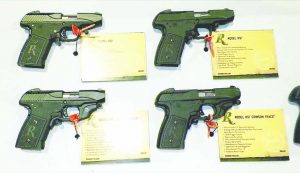
Remington Arms had one of the largest exhibits at the 2018 Shot Show, but big can be not so good. Shortly after the show, the word came out the oldest US arms company was in deep doo doo and had filed for bankruptcy. Old E.R. would turn over in his grave if the quality arms he originated in 1816 folded. The handgun line, including the R51 model shown here, hasn’t set the world on fire in sales.
In the interim years the Show was held at a number of different locations around the US from San Francisco in California to Atlanta, Georgia. (Due to the unhealthy firearms climate in California the Show will never be held there again, or in Illinois, unless there are some drastic political changes. Frisco did have some interesting things to do and see after Show hours, such as Chinatown (great food), Fisherman’s Wharf, cable cars, the Mint—it actually moved during the 1906 quake, the second crookedest street in the US, and possibly the world (Snake Alley in Burlington, IA, ranks first with more curves in a shorter distance), the Bay bridge, and Alcatraz to mention a few.
Other SHOT Show locations have included Houston and Dallas in Texas, New Orleans in Louisiana, Orlando in Florida, and Las Vegas where it originally was at the Convention Center, and later moved to the Sands Expo, apparently due to a schedule conflict. (It was understood by some that the Show would move to a different location every three or four years and rotate back to Vegas. A Vegas/Orlando combo was apparently discussed, but… This would have been excellent, providing an east/west change; dealers and exhibitors from the eastern/mid-west regions now have to travel almost to the west coast for the Show. This travel adds to the expense, although Vegas does have plenty of room accommodations and food is not a problem, although the 99-cent breakfast and the $1.50 buffet disappeared years past. (Houston is so spread out a shuttle bus ride was sometimes 30-50 minutes long depending, and eating was rather limited to the hotel area.)
This shooter/writer would like to see a change from Vegas just for variety. Atlanta, Dallas, New Orleans, or Orlando would be welcome, but housing could be a problem. Orlando would be excellent, as would any of the other three. (The last time in Atlanta the airport closed down after the plane this writer had boarded took off, due to icing problems and ½-inch of snow; the plane was de-iced twice prior to take-off.) For no-Show time there’s plenty to see and the regional food is excellent, or it was, especially in New Orleans.
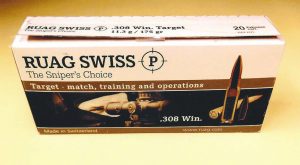
Swiss manufactured RUAG ammunition is not well known in the US, but apparently is well known among the elite military law enforcement snipers.
How large is the SHOT Show? The first Show in St. Louis in 1979 had 5,200 square feet of floor space and 290 exhibitors; some 50 of the original exhibitors, from Aimpoint to Zeiss are still at the Show. In 2017 the Vegas Show had 640,000 square feet of floor space with 1,850 exhibitors, including those in the Supplier Showcase area. Give or take a few, the 1979 Show registered 5,600 dealer attendees, etc., while the 2017 Show registered 64,000 attendees. (How large is 640,000 square feet? Visualize, for comparison, Windsor Castle in England, the Great Pyramid of Giza or the Super Bowl in New Orleans (the Show was held there once)—or a 13 acre field if you are familiar with land measures.) It has 12.5 miles of aisles and exhibit space equivalent to that of 10.9 football fields. It’s the 19th largest trade show in America, the largest held at the Sands Expo Center and the 7th largest such show in Las Vegas.
The ammunition and firearms industry is an $8 billion industry supporting more than 301,000 jobs for a total economic impact of some $51 billion. Sponsored by the National Shooting Sports Foundation (NSSF), the Show attracts exhibitors, buyers, and media from all 50 US states and some 111 countries. It has been said to enhance the Las Vega economy by over $88 million—food, hotels, taxis, workers, etc.
Ammunition available to US shooters and hunters used to be rather limited as to brands available. It was Federal, Remington, or Winchester basically. (In earlier days it may have included such brands as Peters, Robin Hood, and some other long gone cartridges and shotshells of yesteryear. If it was an imported brand it was probably Kynoch (English) or RWS /DWM (German); no Asian brands, or other European labels were available.
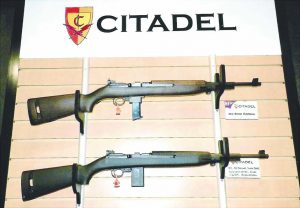
Citadel was not the first to use the M1 Carbine as the basis for a pistol-caliber cartridge. The firm has done an excellent job in adapting the M1 as witness the top carbine here which is chambered for the 9mm Luger cartridge in pistol magazines. The lower carbine is a blow back model chambered for the rimfire 22 Long Rifle cartridge.
Today there are more ammunition brands available to the American shooter than you can literally “shake a stick at.” In addition to the “Big Three” firm—Federal, Winchester and Remington—there were companies at the 2018 Show with such names as Aquila, Black Hills, Gorilla Ammunition, Grizzly Premium Ammunition, Magtech Ammunition, Cor-Bon, Double- Tap, RUAG, and Fiocchi. (Some firms, such as Fiocchi, have factories in the US to save on shipping charges. (It would not be a surprise to see a Chinese ammunition firm build here to tap the American market.)
Grizzly Cartridge Company (info@grizzlycartridge.com) located in Rainier, OR, produces four lines of cartridges—Premium in 31 calibers—rifle and handgun–from 32 ACP to 45-70 Gov’t., Safari in eight rifle calibers from the 375 H & H Magnum, LRH in six most popular long-range calibers from the 6.5 Creedmoor to the 338 Lapua, re-manufactured brass-cased Range in a half-dozen calibers most often found on the target or 3-Gun Competition ranges. The firm also has a Cast Performance line of hard cast lead bullets in 17 sizes from30 to 500 S & W. Although designed for handgun shooters—cowboy action shooters, hunting, target, etc.–they could be used in some rifle cartridges, such as the 38/55, 44-40, 444, and 45, if the size and weight are suitable.
Gorilla Ammunition (gorillaammo.com), a Vero Beach, FL, firm, currently produces three lines of ammunition—Hunt, Target and Silverback Defense. The first two lines feature five popular rifle calibers from the 223 Remington to the 308 Winchester, including the 300 BLK and the 6.5 Creedmoor. The Silverback Defense line includes only four calibers, two handgun calibers—9mm and 45 ACP— and two rifle—260 Remington and 300 BLK.
New to this shooter at least was the veteran owned and operated Bishop Ammunition & Firearms firm (info@bishopammunition.com). The 458 SOCOM cartridge is not new, but it is most often used on an AR-15 platform. Bishop A&F builds a bolt action rifle—the Bolt Action Hunter–for this cartridge that is second to none. Featuring a match air-gauged 16-inch heavy stainless steel barrel with multi-ported muzzle brake fitted to a trued and blue-printed Remington short action 700 receiver with Timney 510 Match Trigger, the Hunter comes with an AICS -pattern 458 SOCOM only 7-round detachable magazine. It’s available with a choice of stocks including the MDT Chassis, Magpul FDE, or Black Hunter.
Bishop also produces a 3G Competition Rifle in 5.56 NATO featuring a stainless steel air-gauged 18-inch barrel length, original gas-operated direct-impingement action, 9-port muzzle brake, choice of stocks—Rodgers 6-position adjustable, Thorsden, or A2 with Monsterman Grip—free-floating 15-inch Keymod handguard with full length Picatinny top rail, oversized tactical charging handle, 30-round magazine (10-round where required), Elftman match trigger, titanium low profile gas block, bolt and carrier, take-down pins, firing pin, and more. Accuracy guaranteed is 1 m.o.a, or less for three shots. The metal finish can be any color with Cerakote an option.
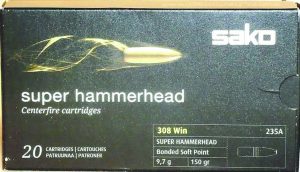
SAKO is known for manufacturing excellent rifles and for some big game cartridges of their design. They also have a line of ammunition featuring SAKO-designed bullets.
Bishop also has ammunition in 458 SOCOM, 9mm Luger, 40 S&W, 45 ACP, 45 Colt, and possibly other calibers (such as the 380 ACP?) as the line expand. Currently the 458 is loaded with the 300 grain Barnes solid copper TTSX bullet, with the 45 Colt available in a Defense load with a solid copper 225 grain hollow-point bullet or a Cowboy Action round with a flat nose lead bullet.
Diamond Ammunition, a female owned Kearney, NE, firm (www.DaimondAmmunition.com) advertises Performance by Design, handgun ammunition in brass or stainless steel cases, new or reloaded, using Clean Sweep technology.
G2 Research (g2rammo.com) produces some of the most advanced technology designed handgun ammunition available to shooters today. It turns handguns chambered for cartridges designed more than a century ago, such as the 380 ACP (9mm Kurz, 9mm Corto, etc., it’s the same cartridge) into powerhouses; be SURE the handgun is modern, in good working condition and capable of handling modern ammunition.
Currently there are at least three G2 lines of handgun ammunition—Civic Duty, R.I.P., and Telos. Available in most popular handgun calibers—380 ACP, 9mm Parabellum (Luger), .357 S&W Magnum, .45 ACP, etc.–this G2 is capable of stopping most baddies in their tracks…unless possibly it’s a native Moro hopped up on fermented joy-juice. The various rounds are loaded with patent-pending solid copper hollow-point projectiles designed to expand rapidly and dump their energy in the target.
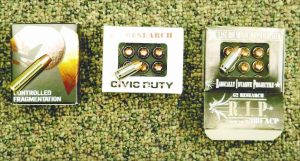
Among the best-designed ammunition at the 2018 SHOT Show was that of G2 Research. Note two of the three boxes have windows to permit views of the nose surface of the cartridges housed in the box. The .38 Special round on the left has a deep hollow point to permit controlled break-up or fragmentation, while the two—Civic Duty and R.I.P. (Radically Invasive Projectile) have deep hollow points with serrated edges.
The R.I.P. (Radically Invasive Projectile) round is loaded with a 62-grain solid bullet featuring a deep cavity, six -point/notches on the nose edges, and two encircling body grooves. (This is advertised as being “The last round you will ever need.”)
The big news at Federal was the Valkyrie, a 224 caliber centerfire cartridge capable of 1,000-yard hits on target. According to Federal the Valkyrie is capable of producing a sonic boom at 1,300 yards. Currently there are four loads available, featuring 90-grain bullets—Gold Medal Sierra MatchKing and the Fusion MSR– and one each with 60-grain and 75-grain bullets—American Eagle TMJ and Nosler Ballistic Tip, respectively. Tests with the 90-grain MatchKing at 1,000 yards indicate as much as 127.88 inches less drop and 68.75 inches less wind drift than many other competitive cartridges; this makes it comparable to the 6.5 Creedmoor, but with less felt recoil.
Federal Premium has another new handgun load, the Hydra-Shok Deep, enhanced to penetrate 50 percent deeper than the original Hydra-Shok rounds. (federalpremium.com/hsd) currently available in 9mm, 40 S&W, and 45 ACP loads only. (Hopefully this Deep design will appear in the 380 ACP and 38 Special rounds later.)
Modified AR-15/AR-10 handguards, magazines, charging levers, etc., M1911 slides, hammers, safety tangs, assorted cosmetic alterations, and suppressors, seemed to make up a large part of the 2018 SHOT Show. They probably did not, but ii seemed that way.
In the golden days of yore the firm of O.F. Mossberg & Sons was known for its lines of great bolt action shotguns and rimfire—bolt action and autoloading—rifles. Decades ago the firm branched out with a line of over/under (Pedersen) shotguns, bolt action centerfire rifles, and the renowned pump or slide action Model 500 shotgun. For 2018 the latest Mossberg offering is the bolt action MVP Precision Rifle with choice of 20 or 24-inch free-floating medium bull barrel in 7.63mm NATO or 6.5mm Creedmoor. (The Creedmoor chambering is also now available in the walnut-stocked Revere rifle line.) Other features of the MVP include a Luth-AR MBA-3 adjustable buttstock, Magpul MOE pistol grip, detachable box magazine, LBA trigger, oversize bolt handle, and a Picatinny top rail on the receiver. It is available in a combo package with a mounted Viper HS-T riflescope.
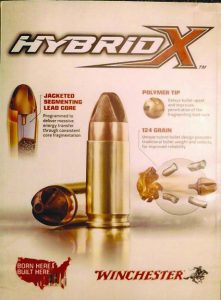
Winchester was promoting a slightly different type of handgun round. Maybe not 100 percent new—a bullet with an object in the nose—but a different shaped nose insert. Not a steel BB, not a bronze tip or a polymer ball, not an explosive primer, but a polymer nose insert having three slightly angled grooves.
One of this shooter’s favorite handguns has always been the FN Browning Hi-Power or M1935, one of the last designs on which John M. Olin actually worked. The grip felt good, the pistol pointed well, and it had a 14-round capacity, bettered at that time by some of the M96-type Mausers with 20-round magazines, or the P’08 with a detachable 32-round snail magazine. Reliability of the Hi-Power? Excellent!
The latest FN pistol is the striker-fired FN 509; no outside or external hammer, but still chambered for the reliable century plus old 9mm Parabellum or Luger cartridge. No longer all steel and walnut, the 509 features a steel barrel and slide, etc., and a polymer frame with enhanced grip texture and interchangeable backstrap. Reliable? If having one million rounds put through the prototype counts the answer is YES!
Remington has a new version of their Model 870 shotgun known as the Model 870 DM Magpul. This latest 870 features a ventilated Magpul SGA forearm and stock with Supercell recoil pad, a barrel length of 18½ inches, tactical REM Choke, XS Ghost Ring rear sight with tactical receiver rail, detachable box magazines with 3 and 6-round capacity.
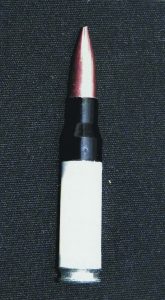
Polymer cased small ammunition is coming. It has been here—off-and-on—for a score of years or more, but usually in handgun or small-bore rounds. The rounds examined at the 2018 SHOT Show were belted 7.62 NATO. The head holding the primer is still metal, but the body is a polymer capable of withstanding high temperatures and pressures.
When the Glock 17 pistol first made its appearance years back many people (liberal media and the usual poo-pooers) had much to say about the synthetic handgun. Today, the Glock handguns (us.glock.com) are entering Generation 5 with the introduction of the Glock 26 Gen5 pistol in 9mm (www.gen5.glock.us). This latest pistol features a Marksman barrel with enhanced polygonal rifling, improved muzzle crown, ambidextrous slide stock, a tough and more endurable DLC finish on metal parts, and no finger grooves on the grip surfaces. Overall, the entire Gen5 line, which includes the G26 and G34 pistols, will have 20 design modifications over the predecessor Gen4 Glock pistols.
Austrian-born, the Glock firm will be celebrating 32 years in the US in 2018. With three internal safeties, and a polymer-based frame, the Glock pistols are in use worldwide. The Smyrna, GA, firm could borrow the motto of a flower firm, paraphrased of course, “When you care enough to use the best, pick a Glock.”
High magazine capacity, bullpup-style pump-action shotguns have become popular in recent years and one of the latest is the Texas-manufactured (emptyshell.us) Defense 12 Bullpup. Featuring an overall length of just over 26 inches with a barrel length of 18-1/8 inches the Defense 12 utilizes detachable box magazines—5 or 10-round capacity—standard length 2-3/4 inches 12 gauge shells only. Other features include a 2-pin disassembly, ambidextrous ejection, removable trigger-pack, and a rotating 3-lug bolt. Reasonably priced, comparably speaking, it should find a ready market among home owners.
Only a few of the many new and different shooting, hunting, and outdoor trade products introduced at the 2018 Show have been covered. Watch for others in an upcoming report to follow.



